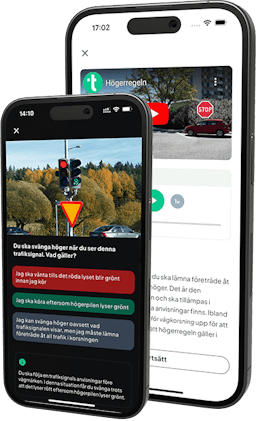The Cooling System
When the engine is running, it generates a lot of heat. There is a cooling system in place to make sure that the engine doesn’t overheat and become damaged. Most engines are cooled with a liquid which is pumped through the engine. The cooling liquid typically consists of 50% glycol and 50% water.
The cooling system does not require much maintenance, however it is important that you regularly check there is enough liquid in the system. Top up with water and glycol as necessary.
Glycol lowers the freezing point of the cooling liquid, so that it doesn’t freeze even in minus temperatures. It is therefore important to check the quantity of glycol in the system before winter. You can do this by using a glycol meter, which you can borrow from a filling station.
The temperature of the cooling liquid is shown on a gauge on the dashboard. If the temperature is too high, there are a number of possible reasons for this.

Factors that can cause high liquid temperatures:
- There may be a leak in the cooling system. Let the engine cool down before topping up the liquid. If you open the cap to the cooling liquid compartment when the engine is warm, hot steam may spray out and there is a risk that you will be scalded.
- The water pump or the fan may have stopped.
- If the engine is fitted with an electric cooling fan, a fuse may have blown, causing the fan to stop.
- In cold temperature, an ice plug may form in the cooling system, which can impair circulation in the system.
The Lubrication System
A car engine has a number of moving parts which move at high speeds. So that the engine does not seize up and break, it needs to be constantly lubricated with oil. The oil is pumped under pressure to the various parts of the engine. Check the oil level regularly and top up as necessary.
If the oil pressure indicator lamp lights up when you are out driving, you must stop and turn off the engine immediately. It may be sufficient to simply top up the oil, but if that doesn’t work, you will need to take the car into a garage to have the problem fixed.

The Fuel System
Most cars are powered by either diesel, petrol or ethanol. During combustion, fuel in the engine is combined with a large quantity of air which is drawn in through an air filter. It is important that the air filter does not become clogged. If the air filter is clogged, the engine will have to work harder to draw in air, which will reduce engine performance and increase fuel consumption.
The Engine Exhaust System
Exhaust fumes from the engine contain a large number of substances which are harmful to people and to nature. In order to reduce the emission of hazardous substances, many cars are fitted with a catalytic converter. Catalytic converters clean exhaust fumes from hazardous substances by around 80–95%.
Carbon monoxide poisoning
Although the catalyst converter cleans exhaust fumes, they can still contain harmful quantities of carbon monoxide. You should therefore never run the engine in a garage or other enclosed space, as doing so will put you at risk of carbon monoxide poisoning.
Carbon monoxide gas is difficult to detect as it is both odourless and colourless. If you begin to experience symptoms of carbon monoxide poisoning, such as headache and nausea, get fresh air as soon as possible.
The Electrical System
The alternator
The alternator generates electricity which is then stored in the battery. The alternator is powered by the car’s engine with help from the alternator belt.
If the charging lamp on the dashboard lights up, this means that the battery is not being sufficiently charged.
Reasons for the battery charging poorly or not at all:
- If the alternator belt is poorly tensioned, it may slip and the battery will charge poorly.
- If the alternator belt is worn, there is a risk that it will come off. If this happens, the alternator will not be able to charge the battery.
- The alternator might be defective.
If the charging lamp comes on, you will be able to take yourself to the nearest garage safely. The worst thing that can happen is that the battery becomes discharged.

The battery
The car’s battery stores electricity that is generated by the alternator. It is very important that the battery is charged in the winter time. A poorly charged battery can be at risk of freezing in low temperatures.
Older batteries often require maintenance. Make sure that the fluid in the battery comes all the way up to the mark and top up with distilled water as necessary.
Modern batteries are often maintenance-free, which means that they never need to be refilled with distilled water.
Jump starting
If the car’s battery is poorly charged or completely discharged, the starter motor will not be able to start the car’s engine. Using jumper cables connected to a battery in another car, you can lead power into the discharged battery to start the car engine. When using jumper cables to start your car, it is important the all the cables are connected correctly. Otherwise, the batteries might short-circuit and electronic equipment may be damaged.

Proceed as Follows:
- Connect the positive terminals together using a jumper cable.
- Connect the negative terminal on the assisting battery to a metal surface on the car being jump started with the other jumper cable.
- Start the engine on the assisting car.
- Start the engine on the car being jump started.
Fuses
The car’s electronic components are fitted with fuses to protect them. Fuses also protect against fire and short-circuiting. If any of the electronic components stops working, check that all of the fuses are intact. You will find them under the dashboard or in a box in the engine compartment.


